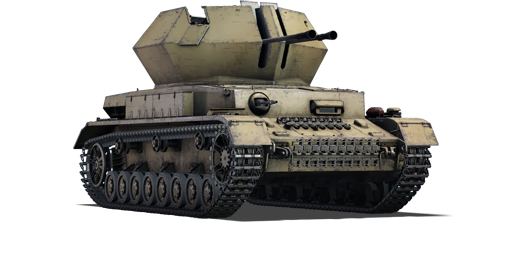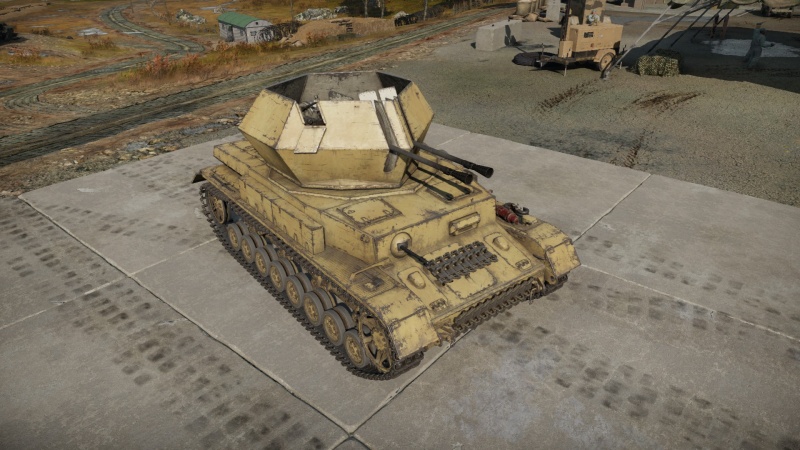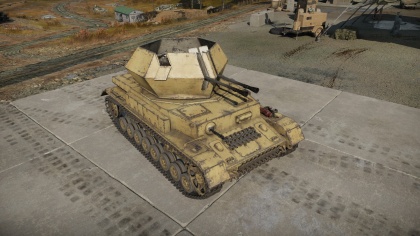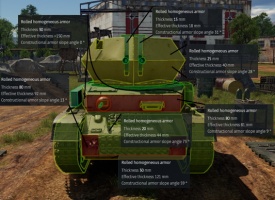Difference between revisions of "Ostwind II"
(→Ammo racks) |
|||
| Line 1: | Line 1: | ||
| − | {{Specs-Card|code=germ_flakpanzer_IV_Ostwind_2}} | + | {{Specs-Card |
| + | |code=germ_flakpanzer_IV_Ostwind_2 | ||
| + | |images={{Specs-Card-Image|GarageImage_{{PAGENAME}}.jpg}} | ||
| + | }} | ||
== Description == | == Description == | ||
| Line 13: | Line 16: | ||
== General info == | == General info == | ||
=== Survivability and armour === | === Survivability and armour === | ||
| + | {{Specs-Tank-Armour}} | ||
<!-- ''Describe armour protection. Note the most well protected and key weak areas. Appreciate the layout of modules as well as the number and location of crew members. Is the level of armour protection sufficient, is the placement of modules helpful for survival in combat? If necessary use a visual template to indicate the most secure and weak zones of the armour.'' --> | <!-- ''Describe armour protection. Note the most well protected and key weak areas. Appreciate the layout of modules as well as the number and location of crew members. Is the level of armour protection sufficient, is the placement of modules helpful for survival in combat? If necessary use a visual template to indicate the most secure and weak zones of the armour.'' --> | ||
[[File:Ostwind II armour.jpg|alt=Ostwind II armour|right|thumb|x200px]] | [[File:Ostwind II armour.jpg|alt=Ostwind II armour|right|thumb|x200px]] | ||
| Line 25: | Line 29: | ||
=== Mobility === | === Mobility === | ||
| + | {{Specs-Tank-Mobility}} | ||
<!-- ''Write about the mobility of the ground vehicle. Estimate the specific power and manoeuvrability, as well as the maximum speed forwards and backwards.'' --> | <!-- ''Write about the mobility of the ground vehicle. Estimate the specific power and manoeuvrability, as well as the maximum speed forwards and backwards.'' --> | ||
| Line 30: | Line 35: | ||
The {{PAGENAME}} does not have that great average speed, which means that the 39 km/h will be rare on the battlefield. Forget about trying to turn on the spot as this vehicle does not have neutral steering. Even worse is attempting to use the reverse gear (-7 km/h) which is extremely insufficient presenting an easy target if having to back out of a tight situation. | The {{PAGENAME}} does not have that great average speed, which means that the 39 km/h will be rare on the battlefield. Forget about trying to turn on the spot as this vehicle does not have neutral steering. Even worse is attempting to use the reverse gear (-7 km/h) which is extremely insufficient presenting an easy target if having to back out of a tight situation. | ||
| + | |||
| + | === Modifications and economy === | ||
| + | {{Specs-Economy}} | ||
== Armaments == | == Armaments == | ||
| + | {{Specs-Tank-Armaments}} | ||
=== Main armament === | === Main armament === | ||
| + | {{Specs-Tank-Weapon|1}} | ||
<!-- ''Give the reader information about the characteristics of the main gun. Assess its effectiveness in a battle based on the reloading speed, ballistics and the power of shells. Do not forget about the flexibility of the fire, that is how quickly the cannon can be aimed at the target, open fire on it and aim at another enemy. Add a link to the main article on the gun: <code><nowiki>{{main|Name of the weapon}}</nowiki></code>. Describe in general terms the ammunition available for the main gun. Give advice on how to use them and how to fill the ammunition storage.'' --> | <!-- ''Give the reader information about the characteristics of the main gun. Assess its effectiveness in a battle based on the reloading speed, ballistics and the power of shells. Do not forget about the flexibility of the fire, that is how quickly the cannon can be aimed at the target, open fire on it and aim at another enemy. Add a link to the main article on the gun: <code><nowiki>{{main|Name of the weapon}}</nowiki></code>. Describe in general terms the ammunition available for the main gun. Give advice on how to use them and how to fill the ammunition storage.'' --> | ||
{{main|FlaK44 (37 mm)}} | {{main|FlaK44 (37 mm)}} | ||
| Line 132: | Line 142: | ||
=== Machine guns === | === Machine guns === | ||
| + | {{Specs-Tank-Weapon|2}} | ||
<!-- ''Offensive and anti-aircraft machine guns not only allow you to fight some aircraft but also are effective against lightly armoured vehicles. Evaluate machine guns and give recommendations on its use.'' --> | <!-- ''Offensive and anti-aircraft machine guns not only allow you to fight some aircraft but also are effective against lightly armoured vehicles. Evaluate machine guns and give recommendations on its use.'' --> | ||
{{main|MG34 (7.92 mm)}} | {{main|MG34 (7.92 mm)}} | ||
Revision as of 09:35, 28 December 2020
Contents
Description
The Flakpanzer IV Ostwind II is a rank IV German self-propelled anti-aircraft gun
with a battle rating of 5.7 (AB) and 5.3 (RB/SB). It was introduced in Update 1.91 "Night Vision", replacing the Flakpanzer 341 in the German tech tree.
The Ostwind II is an average SPAAG which definitely has nothing to look for on the front line, however, there is a great advantage with its double cannon which becomes extremely dangerous for enemy aircraft which fly within range.
The Ostwind II has sufficient penetrating power to destroy M18s or other light armoured vehicles, however, one should rather concentrate on enemy aircraft. The reasoning behind this is because the turret is open from above and weakly armoured on the sides, so is vulnerable to enemy aircraft fire and vehicles that carry .50 calibre machine guns.
General info
Survivability and armour
The frontal hull armour (80 mm) is quite well protected against small-calibre weapons and .50 caliber BMGs, the sides (30 mm) and rear (20 mm) are not as well protected.
The turret is open at the top and has a rectangular recess in the right, frontal turret armour, because of the optics.
In addition, the steel of the turret (25 mm) is very weakly armoured, as well as the hull roof (10-12 mm).
Since the vehicle has a crew of six, with the driver and the machine gunner/radio operator in the hull, it usually survives the first attack from enemy aircraft as well as a shot into the turret.
Mobility
| Game Mode | Max Speed (km/h) | Weight (tons) | Engine power (horsepower) | Power-to-weight ratio (hp/ton) | |||
|---|---|---|---|---|---|---|---|
| Forward | Reverse | Stock | Upgraded | Stock | Upgraded | ||
| Arcade | 43 | 8 | 25 | 426 | 572 | 17.04 | 22.88 |
| Realistic | 39 | 8 | 265 | 300 | 10.6 | 12 | |
The Ostwind II does not have that great average speed, which means that the 39 km/h will be rare on the battlefield. Forget about trying to turn on the spot as this vehicle does not have neutral steering. Even worse is attempting to use the reverse gear (-7 km/h) which is extremely insufficient presenting an easy target if having to back out of a tight situation.
Modifications and economy
Armaments
Main armament
| 37 mm FlaK44 (x2) | Turret rotation speed (°/s) | Reloading rate (seconds) | ||||||||||||
|---|---|---|---|---|---|---|---|---|---|---|---|---|---|---|
| Mode | Capacity (Belt) | Fire rate | Vertical | Horizontal | Stabilizer | Stock | Upgraded | Full | Expert | Aced | Stock | Full | Expert | Aced |
| Arcade | 992 (8) | 250 | -10°/+87° | ±180° | N/A | 30.82 | 42.66 | 51.80 | 57.28 | 60.94 | 0.31 | 0.27 | 0.25 | 0.24 |
| Realistic | 20.83 | 24.50 | 29.75 | 32.90 | 35.00 | |||||||||
Ammunition
- Default: APHE · FI-T
- Sprgr. 18: FI-T
- PzGr: APHE
- M.Gr.18: FI-T
| Penetration statistics | ||||||
|---|---|---|---|---|---|---|
| Belt | Penetration @ 0° Angle of Attack (mm) | |||||
| 10 m | 100 m | 500 m | 1,000 m | 1,500 m | 2,000 m | |
| Default | 49 | 46 | 33 | 22 | 14 | 10 |
| Sprgr. 18 | 3 | 3 | 3 | 3 | 3 | 3 |
| PzGr | 49 | 46 | 33 | 22 | 14 | 10 |
| M.Gr.18 | 4 | 4 | 4 | 4 | 4 | 4 |
| Belt details | |||||||||
|---|---|---|---|---|---|---|---|---|---|
| Belt | Type of warhead |
Velocity (m/s) |
Projectile Mass (kg) |
Fuse delay (m) |
Fuse sensitivity (mm) |
Explosive Mass (TNT equivalent) (g) |
Ricochet | ||
| 0% | 50% | 100% | |||||||
| Sprgr. 18 | FI-T | 820 | 0.62 | 0.3 | 0.1 | 49.3 | 79° | 80° | 81° |
| PzGr | APHE | 770 | 0.69 | 1.2 | 9 | 22.1 | 47° | 60° | 65° |
| M.Gr.18 | FI-T | 914 | 0.55 | 0 | 0.1 | 108 | 47° | 56° | 65° |
Ammo racks
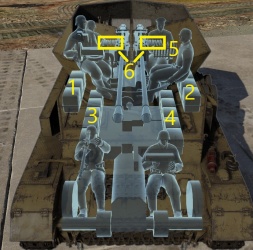
| Full ammo |
1st rack empty |
2nd rack empty |
3rd rack empty |
4th rack empty |
5th rack empty |
6th rack empty |
Visual discrepancy |
|---|---|---|---|---|---|---|---|
| 124 | 92 (+32) | 62 (+62) | 30 (+94) | 6 (+118) | 2 (+122) | 0 (+124) | Yes |
Machine guns
| 7.92 mm MG34 | ||||
|---|---|---|---|---|
| Mount | Capacity (Belt) | Fire rate | Vertical | Horizontal |
| Hull | 1,800 (150) | 900 | -5°/+7° | ±10° |
Usage in battles
- Realistic Battles
The Ostwind II should be held in reserve, for towards the end of the game when there tends to be a significant amount of enemy aircraft flying. It is best to avoid the front lines or beating feet toward the enemy tanks as the Ostwind II tends to be an easy target for a majority of the other tanks in the game.
If your own team is about to lose or it gets very exciting towards the end and there are no many enemies left alive, you can place your Ostwind II inside an allied capture-point to defend it from enemy light tanks. Due to the location, it is more central to the battlefield and presents a difficult challenge for enemy aircraft to attempt to fly over.
It should also be kept in mind that if impenetrable heavily armoured enemies are encountered and you are left with no other option but to engage them, firing in a sustained manner at their cannon barrel is a semi-viable idea. This is because it is entirely possible that it will result in a damaged cannon barrel for the enemy and a chance to escape for you. Furthermore, you can target the tank tracks as well to leave the enemy both harmless and immobile which may possibly net you a kill assist if a teammate with enough firepower is nearby.
Modules
| Tier | Mobility | Protection | Firepower | ||
|---|---|---|---|---|---|
| I | Tracks | Parts | Sprgr. 18 | Horizontal Drive | |
| II | Suspension | Brake System | FPE | PzGr | Adjustment of Fire |
| III | Filters | Crew Replenishment | M.Gr.18 | Elevation Mechanism | |
| IV | Transmission | Engine | Artillery Support | ||
Pros and cons
Pros:
- 2 x 3.7 cm FlaK 44 cannons
- Does not need to reload until it is completely out of ammunition
- Enough penetration to destroy enemy light armoured vehicles
Cons:
- Built on Panzer IV chassis and is a contemporary of it
- Quite slow average speed
- Inadequate penetration against many enemy vehicles (best against aircraft)
History
The Ostwind II was a development of the Ostwind. First conceived as early as October 1943, the Ostwind II saw the single 3.7 cm FlaK 43 replaced by a twinned 3.7 cm FlaK Zwilling 44 built by the Gustloff-Werke in Suhl. One single prototype was delivered to the Panzerflak-Ersatz und Ausbildungsabteilung Ohrsdurf/Thühringen in January of 1945 for evaluation purposes, but due to the rapid events of the war it was never taken into production.
Media
- Skins
- Videos
See also
- Ostwind - Predecessor with a single 37 mm FlaK 43 autocannon.
- Flakpanzer 341 - Gift vehicle that the Ostwind II substituted in the main tech tree.
External links
| Germany anti-aircraft vehicles | |
|---|---|
| Wheeled | Sd.Kfz.222 |
| Half-track | Sd.Kfz.251/21 · Sd.Kfz. 6/2 |
| Flakpanzer IV | Wirbelwind · Ostwind · Ostwind II · Kugelblitz · Zerstörer 45 |
| Other Flakpanzers | Flakpanzer I · Flakpanzer 38 · Flakpanzer 341 |
| Wiesel AWC | Wiesel 1A4 · Ozelot |
| Radar SPAAG | Gepard · Gepard 1A2 |
| Missile SPAA | FlaRakPz 1 · FlaRakRad |


